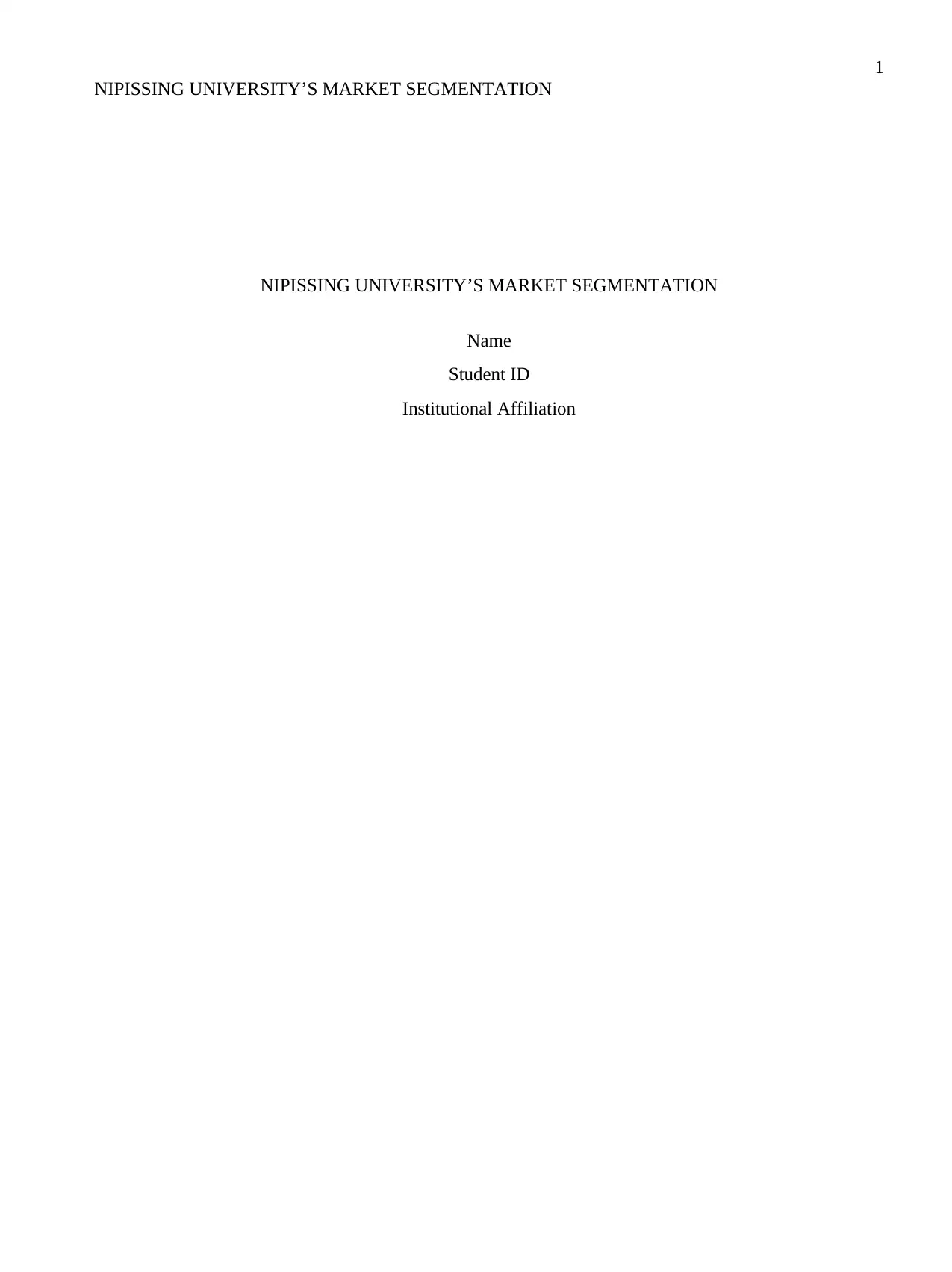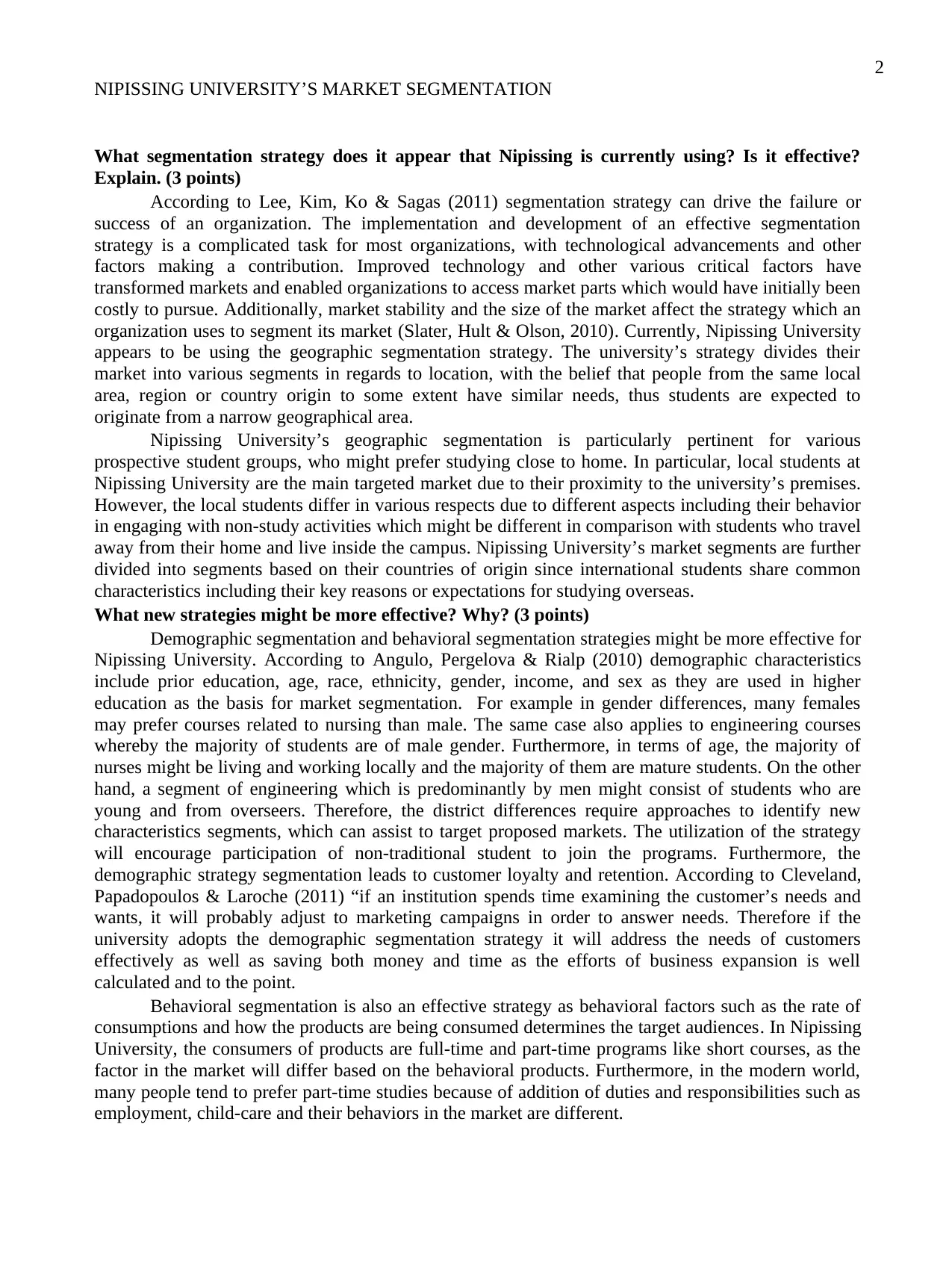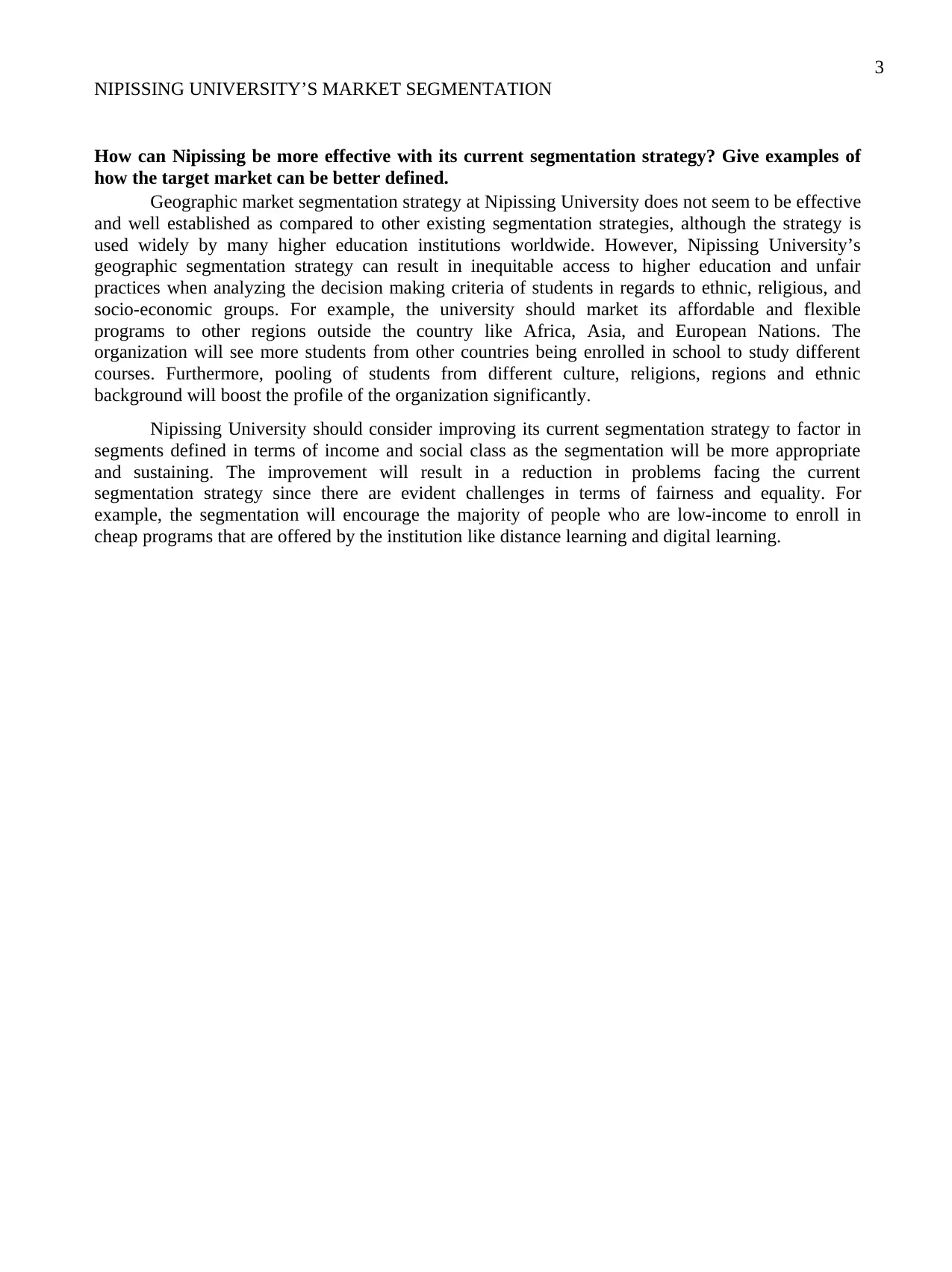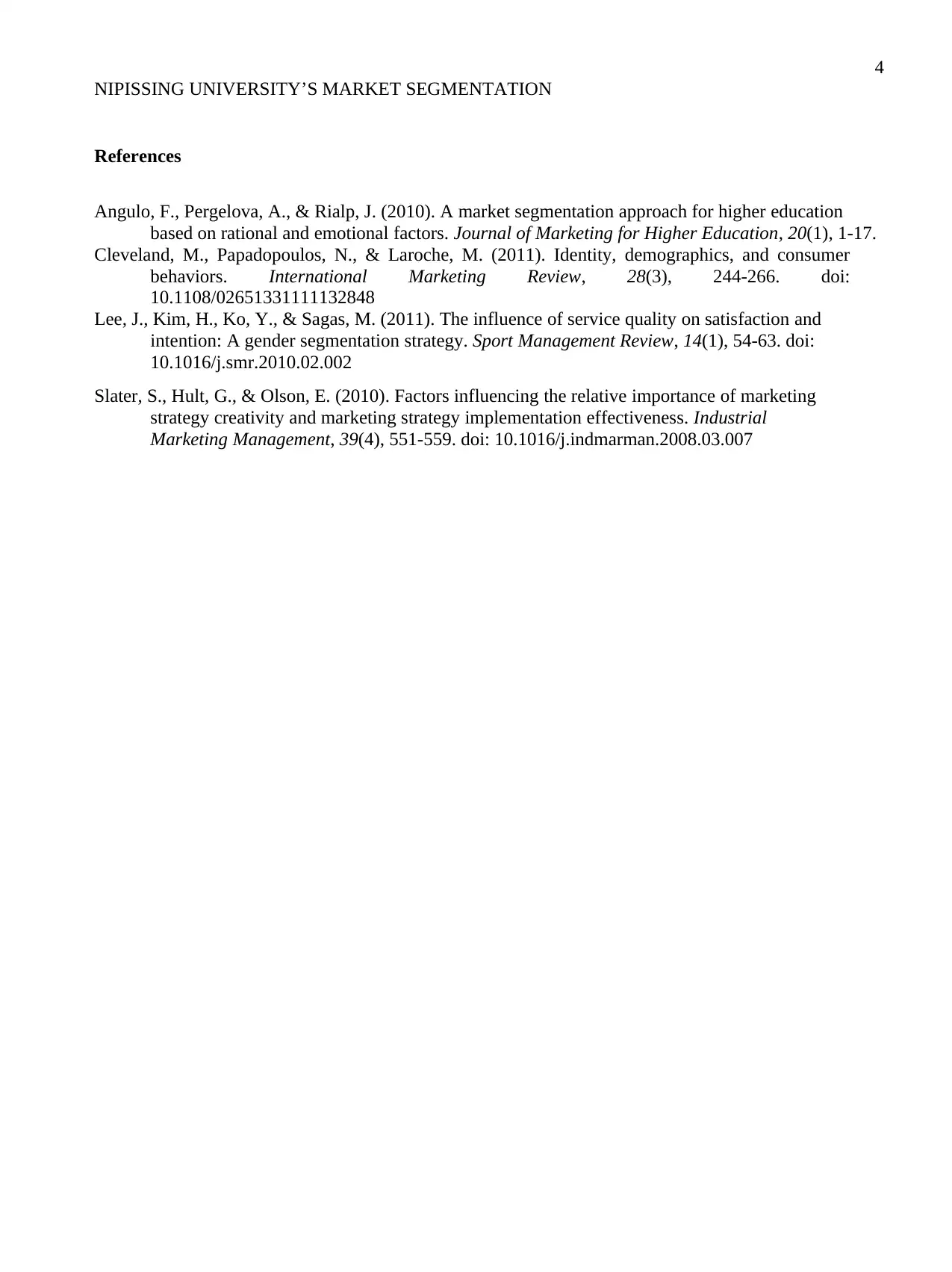Analyzing Market Segmentation Strategies at Nipissing University
VerifiedAdded on 2023/06/04
|4
|1163
|391
Report
AI Summary
This report analyzes the market segmentation strategies employed by Nipissing University. It begins by identifying the university's current use of geographic segmentation, assessing its effectiveness, and explaining the rationale behind this approach. The report then proposes alternative strategies, such as demographic and behavioral segmentation, arguing for their potential to enhance the university's marketing efforts and customer targeting. It explores how Nipissing University can improve its current segmentation strategy, providing specific examples of how the target market can be better defined and how the university can achieve equitable access to higher education. The report incorporates academic research and references to support its analysis and recommendations, contributing to a comprehensive understanding of market segmentation in a higher education context.

1
NIPISSING UNIVERSITY’S MARKET SEGMENTATION
NIPISSING UNIVERSITY’S MARKET SEGMENTATION
Name
Student ID
Institutional Affiliation
NIPISSING UNIVERSITY’S MARKET SEGMENTATION
NIPISSING UNIVERSITY’S MARKET SEGMENTATION
Name
Student ID
Institutional Affiliation
Paraphrase This Document
Need a fresh take? Get an instant paraphrase of this document with our AI Paraphraser

2
NIPISSING UNIVERSITY’S MARKET SEGMENTATION
What segmentation strategy does it appear that Nipissing is currently using? Is it effective?
Explain. (3 points)
According to Lee, Kim, Ko & Sagas (2011) segmentation strategy can drive the failure or
success of an organization. The implementation and development of an effective segmentation
strategy is a complicated task for most organizations, with technological advancements and other
factors making a contribution. Improved technology and other various critical factors have
transformed markets and enabled organizations to access market parts which would have initially been
costly to pursue. Additionally, market stability and the size of the market affect the strategy which an
organization uses to segment its market (Slater, Hult & Olson, 2010). Currently, Nipissing University
appears to be using the geographic segmentation strategy. The university’s strategy divides their
market into various segments in regards to location, with the belief that people from the same local
area, region or country origin to some extent have similar needs, thus students are expected to
originate from a narrow geographical area.
Nipissing University’s geographic segmentation is particularly pertinent for various
prospective student groups, who might prefer studying close to home. In particular, local students at
Nipissing University are the main targeted market due to their proximity to the university’s premises.
However, the local students differ in various respects due to different aspects including their behavior
in engaging with non-study activities which might be different in comparison with students who travel
away from their home and live inside the campus. Nipissing University’s market segments are further
divided into segments based on their countries of origin since international students share common
characteristics including their key reasons or expectations for studying overseas.
What new strategies might be more effective? Why? (3 points)
Demographic segmentation and behavioral segmentation strategies might be more effective for
Nipissing University. According to Angulo, Pergelova & Rialp (2010) demographic characteristics
include prior education, age, race, ethnicity, gender, income, and sex as they are used in higher
education as the basis for market segmentation. For example in gender differences, many females
may prefer courses related to nursing than male. The same case also applies to engineering courses
whereby the majority of students are of male gender. Furthermore, in terms of age, the majority of
nurses might be living and working locally and the majority of them are mature students. On the other
hand, a segment of engineering which is predominantly by men might consist of students who are
young and from overseers. Therefore, the district differences require approaches to identify new
characteristics segments, which can assist to target proposed markets. The utilization of the strategy
will encourage participation of non-traditional student to join the programs. Furthermore, the
demographic strategy segmentation leads to customer loyalty and retention. According to Cleveland,
Papadopoulos & Laroche (2011) “if an institution spends time examining the customer’s needs and
wants, it will probably adjust to marketing campaigns in order to answer needs. Therefore if the
university adopts the demographic segmentation strategy it will address the needs of customers
effectively as well as saving both money and time as the efforts of business expansion is well
calculated and to the point.
Behavioral segmentation is also an effective strategy as behavioral factors such as the rate of
consumptions and how the products are being consumed determines the target audiences. In Nipissing
University, the consumers of products are full-time and part-time programs like short courses, as the
factor in the market will differ based on the behavioral products. Furthermore, in the modern world,
many people tend to prefer part-time studies because of addition of duties and responsibilities such as
employment, child-care and their behaviors in the market are different.
NIPISSING UNIVERSITY’S MARKET SEGMENTATION
What segmentation strategy does it appear that Nipissing is currently using? Is it effective?
Explain. (3 points)
According to Lee, Kim, Ko & Sagas (2011) segmentation strategy can drive the failure or
success of an organization. The implementation and development of an effective segmentation
strategy is a complicated task for most organizations, with technological advancements and other
factors making a contribution. Improved technology and other various critical factors have
transformed markets and enabled organizations to access market parts which would have initially been
costly to pursue. Additionally, market stability and the size of the market affect the strategy which an
organization uses to segment its market (Slater, Hult & Olson, 2010). Currently, Nipissing University
appears to be using the geographic segmentation strategy. The university’s strategy divides their
market into various segments in regards to location, with the belief that people from the same local
area, region or country origin to some extent have similar needs, thus students are expected to
originate from a narrow geographical area.
Nipissing University’s geographic segmentation is particularly pertinent for various
prospective student groups, who might prefer studying close to home. In particular, local students at
Nipissing University are the main targeted market due to their proximity to the university’s premises.
However, the local students differ in various respects due to different aspects including their behavior
in engaging with non-study activities which might be different in comparison with students who travel
away from their home and live inside the campus. Nipissing University’s market segments are further
divided into segments based on their countries of origin since international students share common
characteristics including their key reasons or expectations for studying overseas.
What new strategies might be more effective? Why? (3 points)
Demographic segmentation and behavioral segmentation strategies might be more effective for
Nipissing University. According to Angulo, Pergelova & Rialp (2010) demographic characteristics
include prior education, age, race, ethnicity, gender, income, and sex as they are used in higher
education as the basis for market segmentation. For example in gender differences, many females
may prefer courses related to nursing than male. The same case also applies to engineering courses
whereby the majority of students are of male gender. Furthermore, in terms of age, the majority of
nurses might be living and working locally and the majority of them are mature students. On the other
hand, a segment of engineering which is predominantly by men might consist of students who are
young and from overseers. Therefore, the district differences require approaches to identify new
characteristics segments, which can assist to target proposed markets. The utilization of the strategy
will encourage participation of non-traditional student to join the programs. Furthermore, the
demographic strategy segmentation leads to customer loyalty and retention. According to Cleveland,
Papadopoulos & Laroche (2011) “if an institution spends time examining the customer’s needs and
wants, it will probably adjust to marketing campaigns in order to answer needs. Therefore if the
university adopts the demographic segmentation strategy it will address the needs of customers
effectively as well as saving both money and time as the efforts of business expansion is well
calculated and to the point.
Behavioral segmentation is also an effective strategy as behavioral factors such as the rate of
consumptions and how the products are being consumed determines the target audiences. In Nipissing
University, the consumers of products are full-time and part-time programs like short courses, as the
factor in the market will differ based on the behavioral products. Furthermore, in the modern world,
many people tend to prefer part-time studies because of addition of duties and responsibilities such as
employment, child-care and their behaviors in the market are different.

3
NIPISSING UNIVERSITY’S MARKET SEGMENTATION
How can Nipissing be more effective with its current segmentation strategy? Give examples of
how the target market can be better defined.
Geographic market segmentation strategy at Nipissing University does not seem to be effective
and well established as compared to other existing segmentation strategies, although the strategy is
used widely by many higher education institutions worldwide. However, Nipissing University’s
geographic segmentation strategy can result in inequitable access to higher education and unfair
practices when analyzing the decision making criteria of students in regards to ethnic, religious, and
socio-economic groups. For example, the university should market its affordable and flexible
programs to other regions outside the country like Africa, Asia, and European Nations. The
organization will see more students from other countries being enrolled in school to study different
courses. Furthermore, pooling of students from different culture, religions, regions and ethnic
background will boost the profile of the organization significantly.
Nipissing University should consider improving its current segmentation strategy to factor in
segments defined in terms of income and social class as the segmentation will be more appropriate
and sustaining. The improvement will result in a reduction in problems facing the current
segmentation strategy since there are evident challenges in terms of fairness and equality. For
example, the segmentation will encourage the majority of people who are low-income to enroll in
cheap programs that are offered by the institution like distance learning and digital learning.
NIPISSING UNIVERSITY’S MARKET SEGMENTATION
How can Nipissing be more effective with its current segmentation strategy? Give examples of
how the target market can be better defined.
Geographic market segmentation strategy at Nipissing University does not seem to be effective
and well established as compared to other existing segmentation strategies, although the strategy is
used widely by many higher education institutions worldwide. However, Nipissing University’s
geographic segmentation strategy can result in inequitable access to higher education and unfair
practices when analyzing the decision making criteria of students in regards to ethnic, religious, and
socio-economic groups. For example, the university should market its affordable and flexible
programs to other regions outside the country like Africa, Asia, and European Nations. The
organization will see more students from other countries being enrolled in school to study different
courses. Furthermore, pooling of students from different culture, religions, regions and ethnic
background will boost the profile of the organization significantly.
Nipissing University should consider improving its current segmentation strategy to factor in
segments defined in terms of income and social class as the segmentation will be more appropriate
and sustaining. The improvement will result in a reduction in problems facing the current
segmentation strategy since there are evident challenges in terms of fairness and equality. For
example, the segmentation will encourage the majority of people who are low-income to enroll in
cheap programs that are offered by the institution like distance learning and digital learning.
⊘ This is a preview!⊘
Do you want full access?
Subscribe today to unlock all pages.

Trusted by 1+ million students worldwide

4
NIPISSING UNIVERSITY’S MARKET SEGMENTATION
References
Angulo, F., Pergelova, A., & Rialp, J. (2010). A market segmentation approach for higher education
based on rational and emotional factors. Journal of Marketing for Higher Education, 20(1), 1-17.
Cleveland, M., Papadopoulos, N., & Laroche, M. (2011). Identity, demographics, and consumer
behaviors. International Marketing Review, 28(3), 244-266. doi:
10.1108/02651331111132848
Lee, J., Kim, H., Ko, Y., & Sagas, M. (2011). The influence of service quality on satisfaction and
intention: A gender segmentation strategy. Sport Management Review, 14(1), 54-63. doi:
10.1016/j.smr.2010.02.002
Slater, S., Hult, G., & Olson, E. (2010). Factors influencing the relative importance of marketing
strategy creativity and marketing strategy implementation effectiveness. Industrial
Marketing Management, 39(4), 551-559. doi: 10.1016/j.indmarman.2008.03.007
NIPISSING UNIVERSITY’S MARKET SEGMENTATION
References
Angulo, F., Pergelova, A., & Rialp, J. (2010). A market segmentation approach for higher education
based on rational and emotional factors. Journal of Marketing for Higher Education, 20(1), 1-17.
Cleveland, M., Papadopoulos, N., & Laroche, M. (2011). Identity, demographics, and consumer
behaviors. International Marketing Review, 28(3), 244-266. doi:
10.1108/02651331111132848
Lee, J., Kim, H., Ko, Y., & Sagas, M. (2011). The influence of service quality on satisfaction and
intention: A gender segmentation strategy. Sport Management Review, 14(1), 54-63. doi:
10.1016/j.smr.2010.02.002
Slater, S., Hult, G., & Olson, E. (2010). Factors influencing the relative importance of marketing
strategy creativity and marketing strategy implementation effectiveness. Industrial
Marketing Management, 39(4), 551-559. doi: 10.1016/j.indmarman.2008.03.007
1 out of 4
Related Documents
Your All-in-One AI-Powered Toolkit for Academic Success.
+13062052269
info@desklib.com
Available 24*7 on WhatsApp / Email
![[object Object]](/_next/static/media/star-bottom.7253800d.svg)
Unlock your academic potential
Copyright © 2020–2025 A2Z Services. All Rights Reserved. Developed and managed by ZUCOL.





